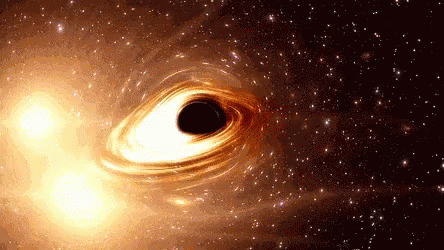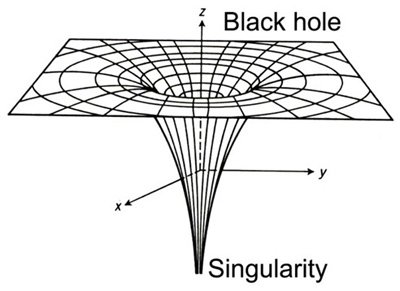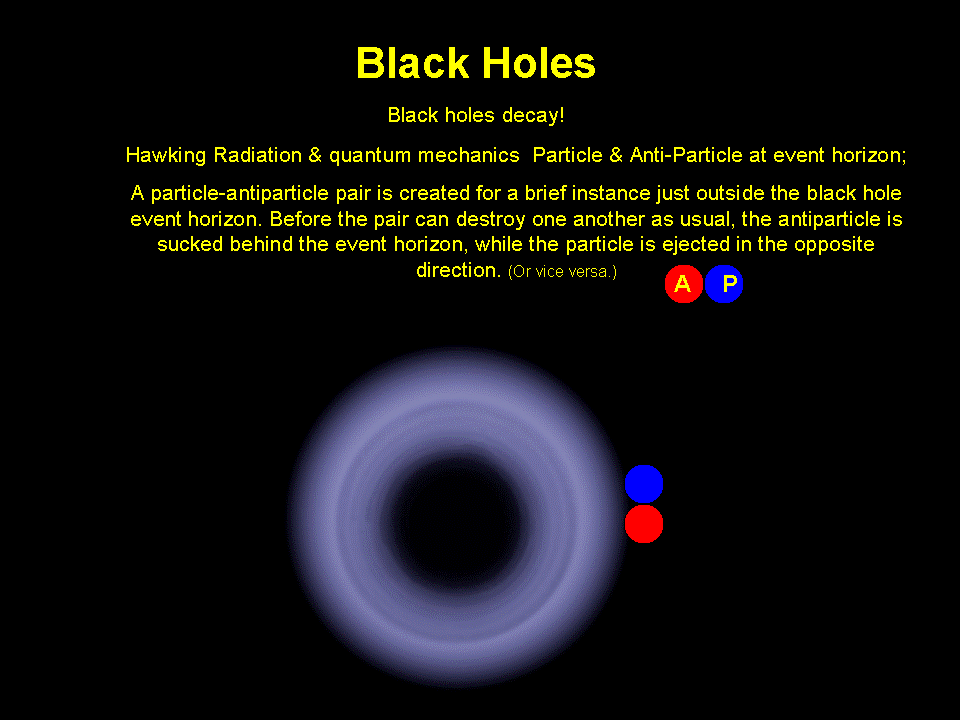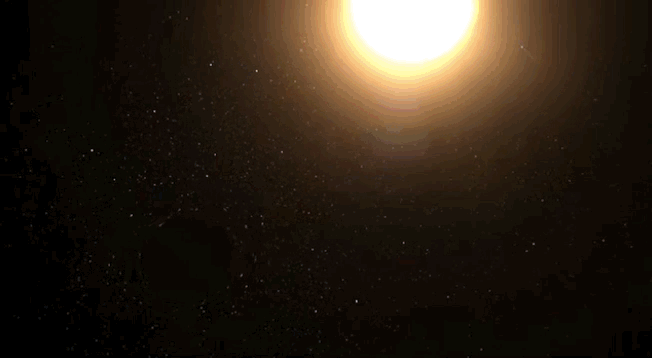Super Cool Science S#!t #24 - The Destroyer of Worlds

Image Source
Black Holes are the most powerful entities in the known universe, and are born of the most violent events we have ever observed. They destroy everything in their path, and leave nothing but a bit of radiation in their wake. They're the stuff of nightmares, but it's not likely we'll ever have to fear these dark behemoths.

What is a Black Hole?
Let's start at the beginning...
When stars many times the mass of our own Sun reach the end of their lives, they implode, collapsing all of their mass into a tightly packed space. Often, this will result in the birth of a neutron star, which I talked about in SCSS #14. If the star has a sufficient amount of mass, though, the gravity produced will collapse that mass even tighter, forming less than a point in space with an infinite amount of gravity, known as a Gravitational singularity.
That "less than" is important, because a singularity is so small, you can't accurately locate it within the three dimensional "coordinate system" of space. The "black hole" itself is actually the space in the immediate vicinity of the singularity, and is "black" because once something gets close enough to the singularity, it would need to move faster than light in order to escape the pull of gravity. This means light itself cannot escape this area, so you can't "see" inside.
The very edge of the black hole is known as the Event Horizon, and marks the "point of no return". Cross this boundary, and you will inexorably be pulled into the singularity. This is where the name comes from. Any event that happens beyond this horizon cannot be known, because the matter that fell in won't come back out to be observed. Don't worry, though, you'll be dead well before you get there, but you'd never realize it. We'll talk a bit more about that in a few minutes.

How big is a black hole?
Black holes come in a wide range of sizes, depending on the mass contained within. According to Einstein's theory of general relativity, any amount of mass that is compacted enough will become a black hole, however small.
As stated above, black holes are typically formed when high-mass stars collapse under their own gravity. In order for this to happen, the original star must contain nearly 3 times the mass of the Sun. These smallest of black holes are around the size of a large city.
One of the largest known black hole lies at the center of a galaxy dubbed NGC-1277 some 220 light years away. This monstrosity has grown to a size a dozen times larger than the orbit of Neptune. It contains as much mass as 14 billion suns, and amounts to nearly 15% of the mass of the entire galaxy!
Nearly all galaxies have a "supermassive" black hole at their center, including our own Milky Way. Most of these black holes, though, only make up about 1% of the mass of the galaxy they inhabit, unlike the giant of NGC-1277.
The size of the black hole is directly related to the amount of mass contained within.
This is known as the Schwarzchild Radius, and is calculated by multiplying twice the mass of the object (in kilograms) by the gravitational constant, and dividing the total by the speed of light (in meters per second) squared.
Using this equation, we can determine that if you had the ability to crush the Earth down enough to create a singularity, the black hole surrounding it would only be the size of a marble! Our hypothetical "micro black hole" would die pretty quickly, though, as it likely wouldn't have enough mass left around it to feast on, and would dissipate through a process known as Hawking Radiation.

How do black holes die?
In order to understand a key part of the answer to that, you might need to throw away something you've been taught since you were a child.
The "empty" vacuum of space isn't actually empty...
At the quantum level, everywhere in space, which includes everything around and in you, tiny pairs of virtual particles are popping into existence and then annihilating one another just as fast. One of these virtual particles is negatively charged, known as the 'antiparticle', and the other is positively charged.
When this happens near the edge of the event horizon of a black hole, the force of gravity can be so overwhelming that before the pair can come back together to annihilate each other, one is pulled over the horizon, while it's pair is flung in the opposite direction. If the negatively charged antiparticle is the one pulled in, the black hole's total energy will decrease, and in turn, so too will the total mass of the black hole, because Einstein said so... (E=MC2)
This is happening all the time, and if there isn't enough mass falling into the singularity, the black hole will eventually evaporate away. Micro black holes like our hypothetical Earth-marble probably wouldn't take in more than they radiate, so would die very quickly, though we've never observed a black hole anywhere near as small as that. Bigger black holes usually have plenty to eat, and together, could end up collectively destroying the entire universe...

What if you fell into a black hole?
It's easy to visualize black holes as big vacuums that suck everything around them up, but as their name would suggest, they act much more like holes. Think of a black hole as a drain in your bathtub, just a simple hole in the bottom that the water (matter in space) will fall into.
As something gets closer and closer to the black hole, the force of gravity will tear it apart, atom by atom. Gravity increases so exponentially near the event horizon that it will pull much stronger on the front of something than the back, which "spaghettifies" it into a one atom thick stream of particles spiraling into the singularity.
During periods of high mass intake, such as when something like a star falls in, an accretion disk is formed, which feeds the singularity over time. Some of this excess matter is carried on the magnetic field generated by the black hole, and is ejected in enormous jets of energy.
So let's imagine you've commandeered yourself a spaceship, and you're going to find out what all the hubbub is about black holes...
You bring your best friend along, who in the beginning, thought this was a great idea, because he hadn't really read up on black holes, but as you approach the behemoth, your friend gets scared and ejects with the only escape pod.
Gravity is starting to pull you closer and closer to the black hole faster and faster every moment. A tricky thing about gravity is that it bends spacetime. The two are one and the same. The more gravity there is in a particular area of space, the slower time will move in that space.
As you come up on the event horizon, your friend turns back to watch your final moments, but they never seem to happen. The closer you get to the horizon, you appear to slow down, eventually seeming to freeze in time all together.
At this point, if you were to look forward, you'd probably see nothing, as all the light would be moving away from you toward the horizon. Look back toward your friend, and you will see the entire future of the universe play out before your eyes, as time is practically frozen for you, but moves along normally outside the black hole's immense field of gravity.

Image Source

Black Holes are ridiculous, and there's a lot more that we could cover...
If you're eager to learn more about these gravitational monstrosities, check out the videos below that go more in-depth about the subject, and cover some other crazy things about black holes...
A crash course on Black Holes - Crashcourse
Stars orbiting the black hole at the center of our Milky Way galaxy - VideoFromSpace
What a black hole would actually look like - Science Editor
Pairs of black holes can create waves in spacetime! - Science Magazine

References:
- https://science.nasa.gov/astrophysics/focus-areas/black-holes
- https://www.forbes.com/sites/startswithabang/2018/01/19/what-would-you-see-as-you-fell-into-a-black-hole/#7a8a63bf8583
- https://www.insidescience.org/news/study-about-nothing
- http://astrosun2.astro.cornell.edu/academics/courses/astro201/bh_structure.htm
- https://wordlesstech.com/biggest-ever-black-hole-17-billion-times-the-mass-of-the-sun/

Thanks for reading! I've now written two dozen SCSS articles, and am ever thankful for all the support this series has received from the many great curation groups we have here. I have something extra special planned for the future, so keep an eye out for more Super Cool Science S#!t!







Great article, should be understandable for the average joe as well. Saved this post for later to watch all these videos as well.
I try to write all of my Super Cool Science S#!t to be plainly understandable. I'm no degreed scientist or anything, I'm just a regular guy talking about science to regular people :D
Thanks for stopping by! As you can probably tell, I have two dozen of these articles on all sorts of topics. I plan to compile them all into a book one day!
sounds great, I will try to read them all. That book would well be one to buy for our family library.
I love the graphics--I'll have to re-read later when I'm wide awake--right now sleep looms. However, have to ask, did you see the movie Event horizon? It deal with a ship that apparently "opened a rift in the space time continuum". Stuff of science fiction but I found the movie to be really creepy. When I re-read your piece I'll try to see how far-fetched the premise of the film is.
Great article! I have been captivated by these for years. Following.
Nice post! One of the first I read after my return from vacation ^^
There are also the hypothetical primordial black holes that were there from the early universe days. But no trace of those so far, in contrast to more normal black holes that have been observed.
PS: you may be interested in some black hole posts I wrote in the past too (too lazy to dig the links :p )
Then there's the even more theoretical White Holes...
Yeah, this is even more hypothetical. The nice feature with the primordial guys is that in principle, the gravitational wave experiments could help to get a final word on them, in contrast to the white hole stuff that sounds more like sci-fi to my ears ;)
I don't get this part. To me, it would seem that it doesn't matter which particle is sucked in, since both the particle and the anti-particle have a certain amount of mass. The difference in charge shouldn't change the amount of energy, according to my understanding about this.
It's very well possible that I misunderstood things, but I simply don't get this part :P
That's a great question, and I suppose I could have explained it a bit better than "because Einstein said so" :D
When an antiparticle collides with a "regular" particle at the event horizon, they eliminate each other, giving off energy. Since the antiparticle came from a pair outside the black hole, it decreases the total number of particles within.
That help?
Alright, so it meets a particle at the event horizon, giving off energy... But wouldn't that mean the energy is still there in the black hole? Or does it happen at the edge, meaning a part of it leaves and a part of it stays?
It is really an exceptional article @thatsweeneyguy, I love it, and I enjoy it a lot. This "black hole" theme is very interesting. Children would love to see a class of these. God bless you friend..
Thanks a lot! I very much enjoy writing these, so I'm glad people receive them well.
I am much more amazed at this, quite Interesting. There are more to know
Very approachable intro to black holes!
Regarding "typically", does that mean the formation of a black hole is not just a matter of the mass of the star, but is also a probability thing? In other words, stars that have the necessary mass won't necessarily form black holes when they collapse?
Could you in principle eradicate any black hole, no matter how big, by starving it of matter?
At what speed?
Now it's time to watch the vids, and possibly answer some of those questions!
Any star with a mass at least 2.8 times that of our sun will collapse into a black hole if it does indeed die by collapsing under it's own gravity. Sometimes, though, black holes are formed by things like colliding neutron stars.
Yes. Any black hole, no matter how large, will eventually radiate away if it does not take in more matter. Even the smallest of observable black holes will take so long to evaporate, though, that all the stars in the universe will likely be dead by then...
This one's tricky. The speed at which the future would play out would increase exponentially as you get closer and closer to the singularity
Thanks for stopping by, and asking questions to understand the topic a bit better!
Keep on learning, and keep on steemin' on!
This post has been voted on by the steemstem curation team and voting trail.
There is more to SteemSTEM than just writing posts, check here for some more tips on being a community member. You can also join our discord here to get to know the rest of the community!
Hi @thatsweeneyguy!
Your post was upvoted by utopian.io in cooperation with steemstem - supporting knowledge, innovation and technological advancement on the Steem Blockchain.
Contribute to Open Source with utopian.io
Learn how to contribute on our website and join the new open source economy.
Want to chat? Join the Utopian Community on Discord https://discord.gg/h52nFrV